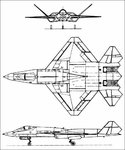ccheese
Member In Perpetuity
The competetion between the Northrop/McDonnell Douglas YF-23 and the
Lockheed YF-22 is history. The YF-23 lost, the YF-22 won. The YF-22
went into production, but what hapened to the YF-23 ? Has the multi-
million dollar aircraft been destroyed ? Is it reposing, somewhere, letting
the weather destroy it ? Or has Northrop or M-D saved it for a museum ?
There was a show (Modern Marvels) on TV that showed the lonely VF-23
sitting on the ramp, somewhere..... abandoned ? I doubt that !
What happens to "one of a kind" aircraft that don't make it into production ?
Some are surely destroyed (like Northrops big flying wing, and Martin's
"Seamaster"), but what happens to the others ?
More info here:
View: https://www.youtube.com/watch?v=FNKw9TrVviE
Charles
Lockheed YF-22 is history. The YF-23 lost, the YF-22 won. The YF-22
went into production, but what hapened to the YF-23 ? Has the multi-
million dollar aircraft been destroyed ? Is it reposing, somewhere, letting
the weather destroy it ? Or has Northrop or M-D saved it for a museum ?
There was a show (Modern Marvels) on TV that showed the lonely VF-23
sitting on the ramp, somewhere..... abandoned ? I doubt that !
What happens to "one of a kind" aircraft that don't make it into production ?
Some are surely destroyed (like Northrops big flying wing, and Martin's
"Seamaster"), but what happens to the others ?
More info here:
View: https://www.youtube.com/watch?v=FNKw9TrVviE
Charles


